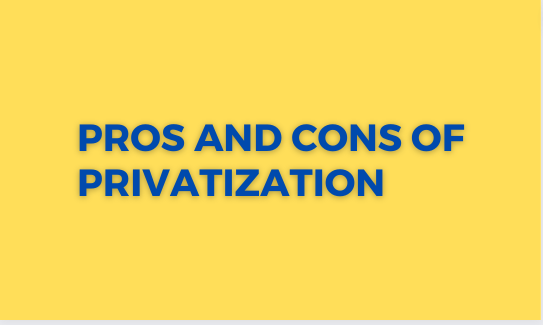Privatization refers to the transfer of ownership, control, or management of public assets or services from the government or public sector to the private sector. It involves the transition of an enterprise or industry that was previously owned, operated, and regulated by the government to private ownership and operation. Below are pros and cons of privatization:
Pros:
- Increased efficiency: Privatization can improve efficiency by introducing competition and market-driven incentives.
- Cost savings: Privatization may lead to cost savings through streamlined operations and reduced bureaucratic overhead.
- Innovation and entrepreneurship: Private companies often bring innovation and entrepreneurial spirit, leading to new ideas and approaches.
- Focus on core competencies: Privatization allows governments to focus on their core responsibilities while outsourcing non-core functions.
- Access to capital: Privatization can attract private investment and access additional capital for infrastructure development.
- Enhanced service quality: Private companies may offer improved service quality and customer satisfaction compared to government-run entities.
- Flexibility and agility: Private companies can respond quickly to market changes and adapt their operations accordingly.
- Technological advancements: Privatization can encourage the adoption of new technologies and drive technological advancements.
- Job creation: Privatization can create job opportunities and stimulate economic growth.
- Expertise and specialization: Private companies often possess specialized knowledge and expertise in specific industries or sectors.
- Increased accountability: Privatization can promote greater accountability through performance-based contracts and clear metrics.
- Risk-sharing: Private companies may assume certain risks associated with operations, reducing the burden on the government.
- Competitive pricing: Privatization can result in competitive pricing, offering consumers more choices and potentially lower prices.
- Improved infrastructure development: Private investment in infrastructure projects can lead to faster and more efficient development.
- Global best practices: Privatization allows the adoption of global best practices in management and operations.
- Stimulated economic competition: Privatization can foster healthy competition, driving economic growth and market efficiency.
- Reduced fiscal burden: Privatization can relieve the government of financial burdens associated with running public enterprises.
- Increased revenue generation: The sale of state-owned assets through privatization can generate significant revenue for the government.
- Transparency and accountability: Privatization often requires transparent processes and reporting, enhancing overall accountability.
- Improved customer choice: Privatization can increase options and diversity in products and services available to consumers.
Cons:
- Loss of government control: Privatization may result in a loss of government control over essential services and strategic assets.
- Potential for monopolies: Privatization can lead to the emergence of monopolies or oligopolies, limiting competition and consumer choice.
- Profit-driven approach: Private companies may prioritize profitability over public interest, potentially compromising certain services.
- Inequality and affordability concerns: Privatization can result in higher costs, making certain services less affordable for low-income individuals.
- Job losses and labor issues: Privatization can lead to job losses, labor disputes, and potentially reduced worker benefits.
- Lack of transparency: Private companies may operate with less transparency compared to public entities, raising concerns about accountability.
- Social service prioritization: Privatization may prioritize profitable services over essential social services that are less financially lucrative.
- Inadequate service provision: Private companies may fail to provide services in underserved or remote areas due to profitability concerns.
- Asset undervaluation: The government may sell state-owned assets below their true value, resulting in potential loss of public wealth.
- Difficulties in contract management: Contract management and oversight of privatized entities can be complex and challenging for governments.
- Regulatory capture: Private companies may influence regulations and policies in their favor, potentially leading to regulatory capture.
- Lack of long-term vision: Private companies may focus on short-term gains without considering long-term sustainability or public interest.
- Loss of cultural heritage: Privatization of certain cultural or historical assets may lead to a loss of public access or preservation.
- Adverse impacts on workers’ rights: Privatization can result in reduced job security, lower wages, and weakened workers’ rights.
- Reduced democratic control: Privatization may limit public participation and democratic control over essential services.
- Disruption of local economies: Privatization can disrupt local economies, particularly in areas heavily dependent on public entities.
- Loss of public influence: Privatization may diminish the ability of the public to influence decision-making and service provision.
- Potential for corruption: The process of privatization can be susceptible to corruption, favoritism, or unethical practices.
- Negative externalities: Privatization may lead to negative social or environmental externalities, which are not adequately addressed by private companies.
- Lack of coordination: Privatization can result in fragmented service provision and lack of coordination between different entities.
Pros
- Increased efficiency
- Cost savings
- Innovation and entrepreneurship
- Focus on core competencies
- Access to capital
- Enhanced service quality
- Flexibility and agility
- Technological advancements
- Job creation
- Expertise and specialization
- Increased accountability
- Risk-sharing
- Competitive pricing
- Improved infrastructure development
- Global best practices
- Stimulated economic competition
- Reduced fiscal burden
- Increased revenue generation
- Transparency and accountability
- Improved customer choice
Cons
- Loss of government control
- Potential for monopolies
- Profit-driven approach
- Inequality and affordability concerns
- Job losses and labor issues
- Lack of transparency
- Social service prioritization
- Inadequate service provision
- Asset undervaluation
- Difficulties in contract management
- Regulatory capture
- Lack of long-term vision
- Loss of cultural heritage
- Adverse impacts on workers’ rights
- Reduced democratic control
- Disruption of local economies
- Loss of public influence
- Negative externalities
- Lack of coordination
- Potential for corruption



